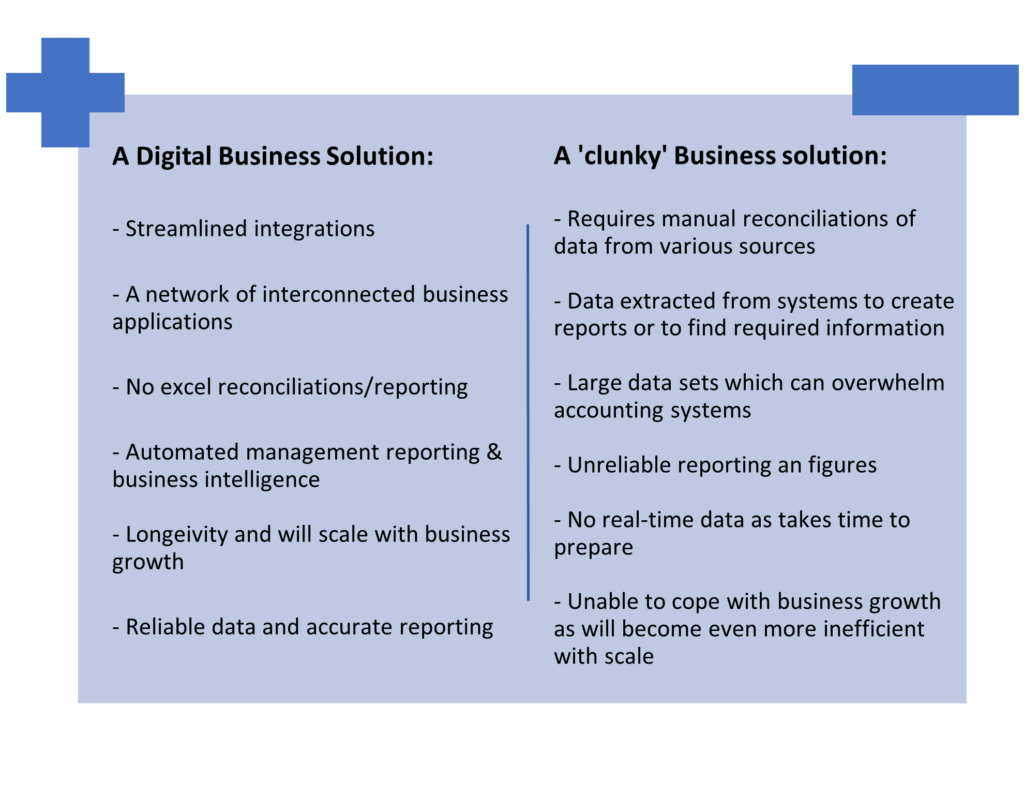When a business begins trading, various operational systems may have been implemented as they made sense at the time and solved a problem, however, the longevity may not have been taken into consideration. Many business owners can find themselves in a position where they have implemented a number of different systems to keep up with their growing business demand but their financial function is inefficient, unreliable and may be overwhelmed by the volume of data. The aim of organisations is to have one version of ‘the truth’ in one centralised database that encompasses all the systems and data from the organisation. However, with that being said, it also means streamlining your process feeds to ensure that each component within your business system network is utilised in the most efficient way.

Below we discuss in detail some examples of challenges businesses may face and some of our suggested solutions to these challenges:
1. Large volumes of data that overwhelm their accounting systems
An accounting system, as with any system, will have a limit on the amount of information that it can handle, and it may start to fracture slightly as the data volume increases. If we take an example of an online retailer who has connected their point of sales to their accounting system – in many cases this integration works on a 1-to-1 basis meaning that a sales transaction will be created every time they make a sale; if they are making a large volume of sales everyday it results in a huge number of small detailed transactions going into their accounting system. This can also be the case for other system integrations resulting in huge amounts of data being pushed into the accounting system. Large transactional volumes can not only be a nightmare to process and reconcile but also may cause your system to run slower than optimum and finding information you need quickly may become increasingly difficult.
2. Reconciliation issues across multiple systems
Some businesses have a range of different systems for various operational purposes which do not integrate or share data, meaning that there is a huge chance that there will be reconciliation issues and inconsistencies. If your finance team are having to extract data sets from various places and compare them this can cause delays in being able to produce meaningful financial reports. It can also lead to time-wasting in Excel spreadsheets during the reconciliation and if there are any issues (such as a payment not received for a sale made) it could result in delays of issues being resolved. Through having multiple siloed systems, you are increasing the number of versions of ‘the truth’ and therefore it will be difficult to decipher which of these systems can be relied upon for the truest information.
3. Incorrect or unreliable reporting
Many businesses will use Excel or similar programs to produce reports as it may seem like an easier way of gaining the exact results which are needed. This however can lead to unreliable reporting that will be extremely error-prone and hard to trace if manual adjustments are made within the sheet. It is tempting for business owners to use Excel to collate information from their various systems to check reconciliations, produce reports and to gather their management information. This, however, can prove to be a costly way of working not only in terms of the time your finance team will need to spend producing this information but also in terms of having access to real-time data that would help you to make better strategic business decisions.
Solutions:
1. Steam-line your integrations
As per the example above regarding the online retailer and their POS integration; the finance team will not need to see each individual product sold every day, they will only be interested in the total revenue figure and VAT information. The detailed sales information will be available within your POS system, so it is unnecessary to send all this information into your accounting system. By integrating a tool which will handle large data sets such as a reporting tool, you can send all the detailed information to one location which can then be condensed down into a single daily journal that can be sent to your accounting system. Through utilising this tool it means you will be able to select which applications actually need to be integrated to your accounting system as some reconciliations (cash, for example) can be done within your reporting tool rather than in the accounting system.
2. Connect all your systems to a centralised database
As mentioned previously, having a reporting tool which can handle large data sets can be used as your centralised database & single source of truth. By building up a network of apps which all direct into a central tool you are automating the reconciliation process. A tool that can collect this data and produce meaningful and useful reports, as well as being able to condense your data and send relevant information into your accounting package will save time, reduce the volume of transactional data and will reduce manual work. You will no longer need to do manual reconciliations and checks as any issues will be flagged up much quicker as it will be a completely automated process. This information will also be in real-time to help business owners get a true reflection of their business performance without the worry that the information they are using is unreliable and not up to date.
3. Use each of your systems for the functionality they provide you
Each app or piece of technology implemented into a business process will have been selected for a particular purpose or functionality. The problem most business owners face is when trying to use systems for another purpose as well as their main function, such as using an accounting package for management reporting rather than for the main purpose: bookkeeping and compliance. The reporting functionality in an accounting package will never be as good or as flexible as a tool that is built specifically for management reporting purposes, therefore, it is best to use each piece of technology for their strengths in order to get the most out of them.
At 4Pointzero we aim to help business owners improve their existing processes by providing advice and implementing tools that help pull together all the information from various applications to automate as much as we can. If you want to discuss how we can help you, please contact us www.4pointzero.co.uk
Frequently Asked Questions (FAQ)
What does it mean to streamline business processes?
Streamlining business processes refers to the optimization and simplification of various operational workflows within an organization. The goal is to enhance efficiency, reduce redundancies, and eliminate unnecessary steps, ultimately improving overall productivity.
Why is streamlining business processes important?
Streamlining processes can lead to numerous benefits, such as increased productivity, reduced costs, faster decision-making, improved customer satisfaction, and better utilization of resources. It allows businesses to adapt more effectively to changes in the market and stay competitive.
How can I identify processes that need streamlining?
Start by analyzing existing processes to identify bottlenecks, delays, or areas with excessive manual intervention. Look for tasks that consume too much time or resources without adding significant value. Customer feedback and employee insights can also provide valuable input.
How can automation help in streamlining processes?
Automation can significantly improve efficiency by handling routine tasks, reducing errors, and accelerating processes. Tasks like data entry, invoicing, and customer onboarding can be automated, freeing up human resources for more strategic and value-added activities.
Is there a one-size-fits-all solution for process streamlining?
No, every business is unique, and the approach to streamlining processes should be tailored to the specific needs and goals of the organization. While there are best practices, customization is essential to address the unique challenges each business faces.
What role does technology play in process streamlining?
Technology provides tools for automation, data analysis, and real-time monitoring. Businesses can leverage software solutions, workflow management systems, and communication platforms to streamline processes, enhance collaboration, and make informed decisions.



